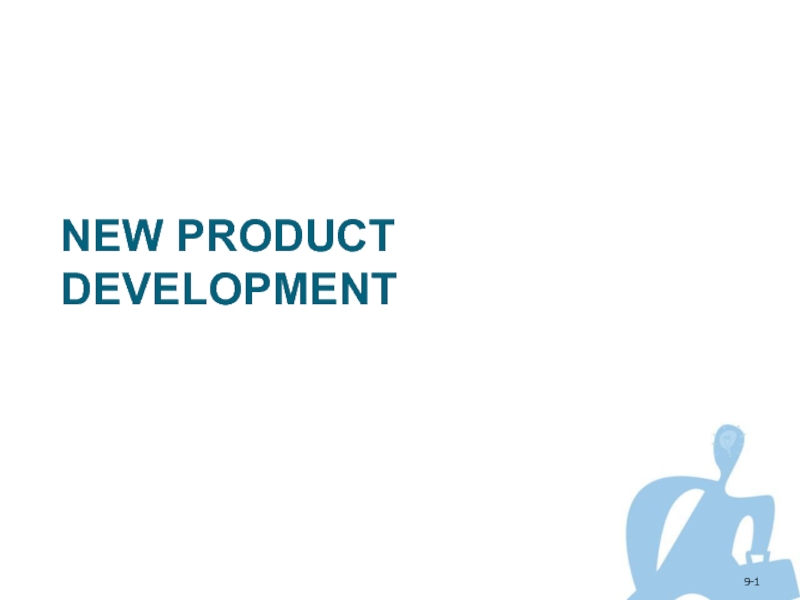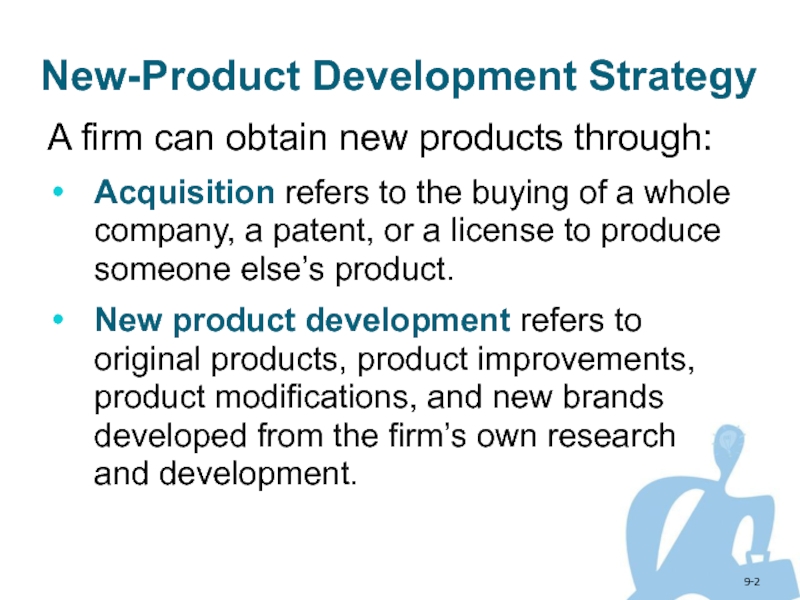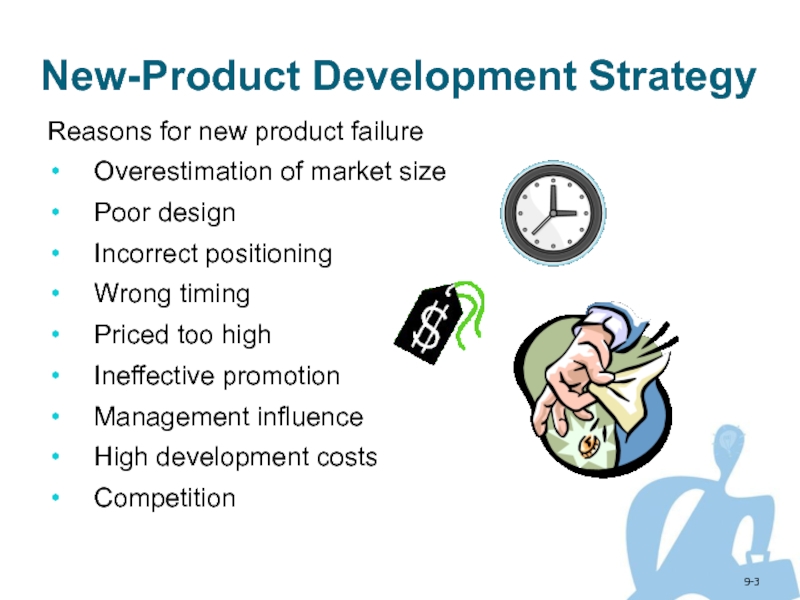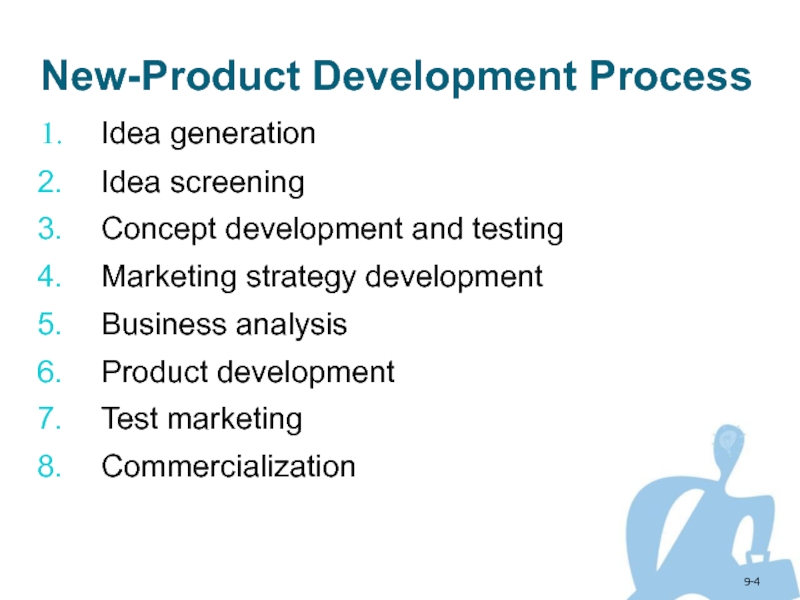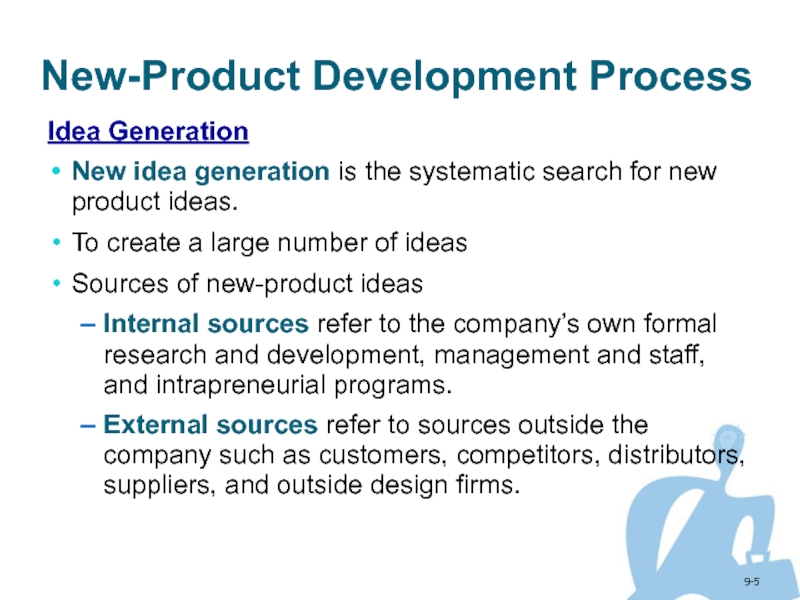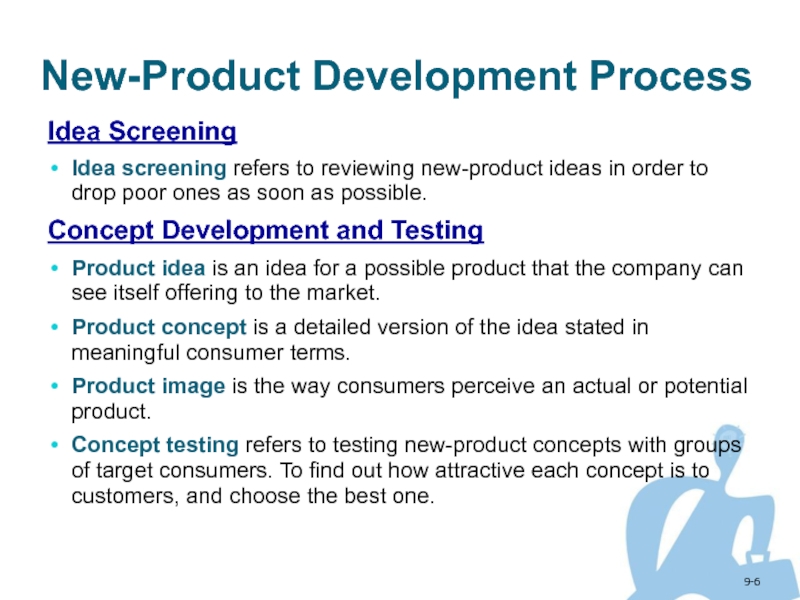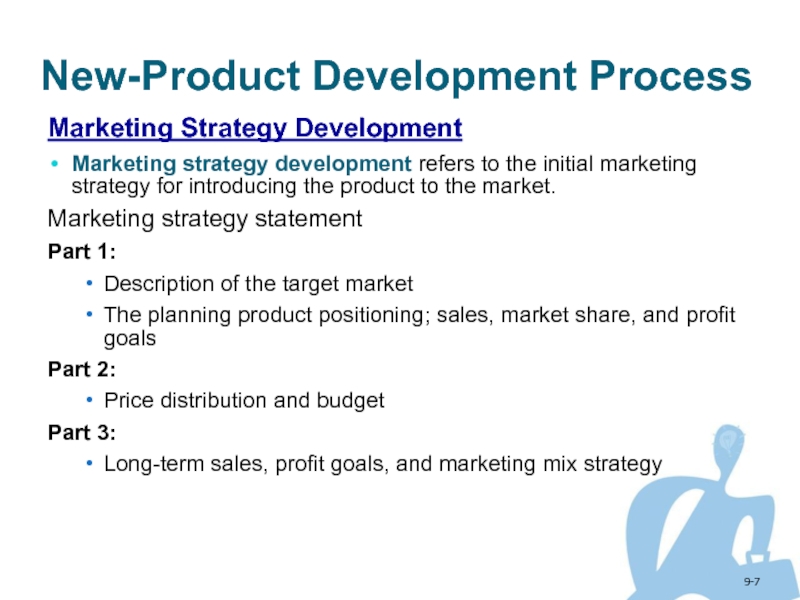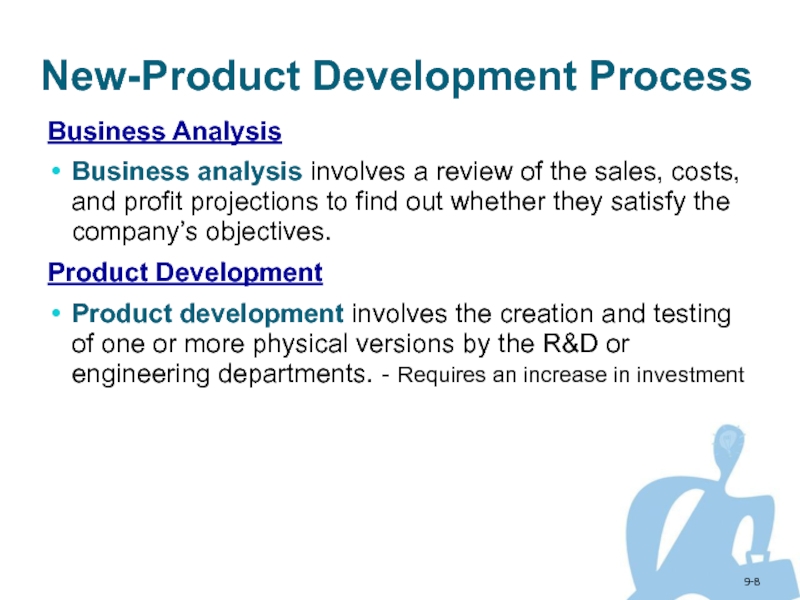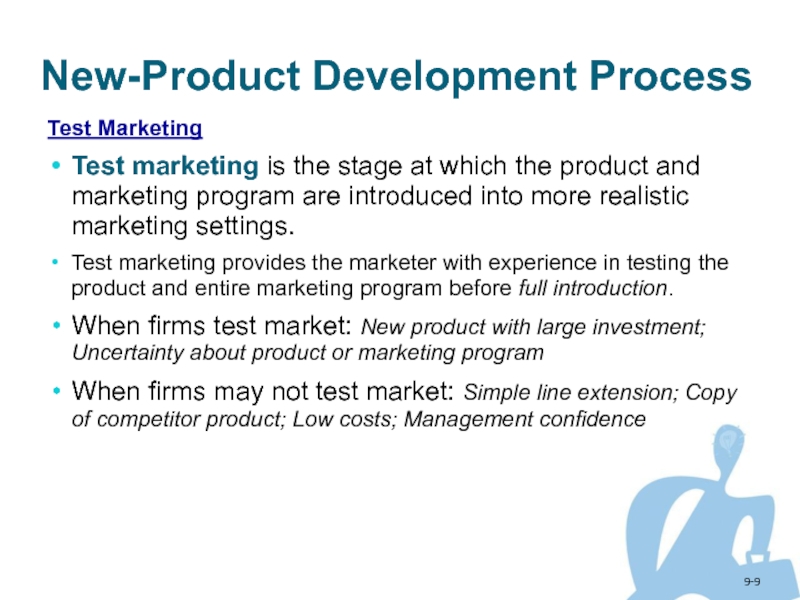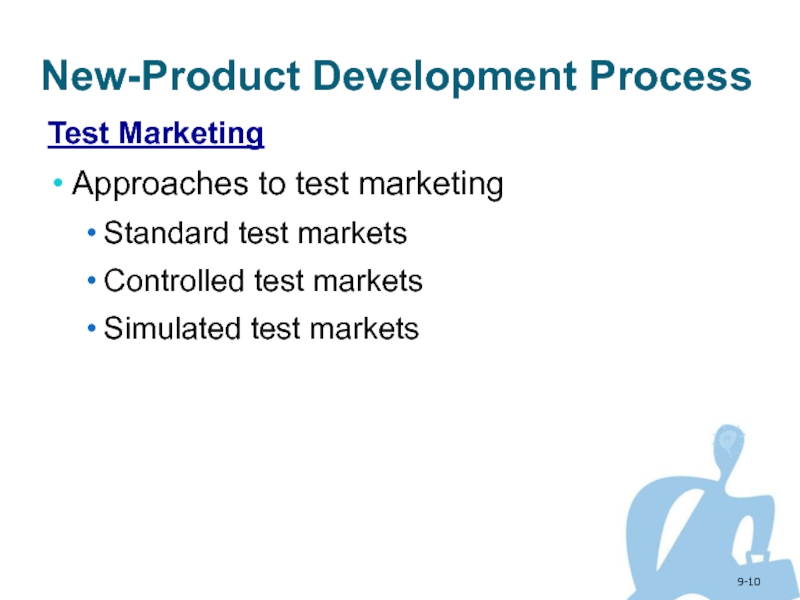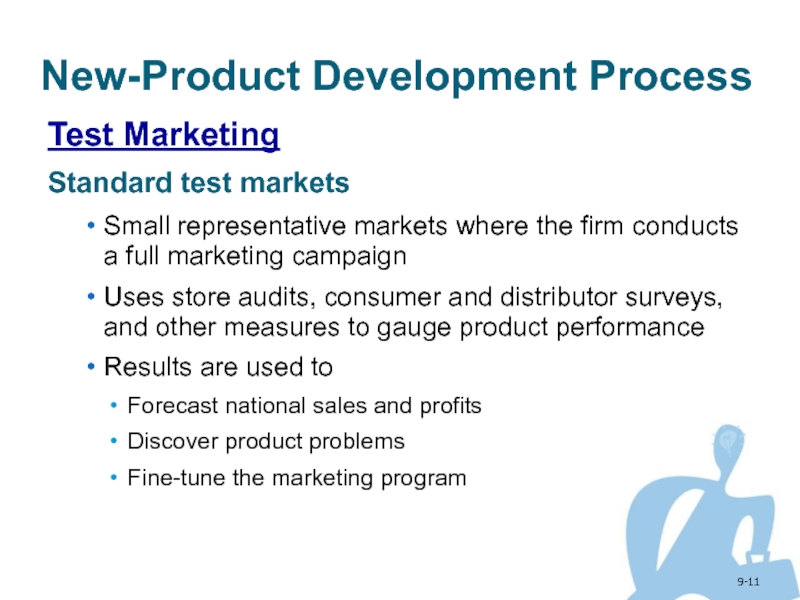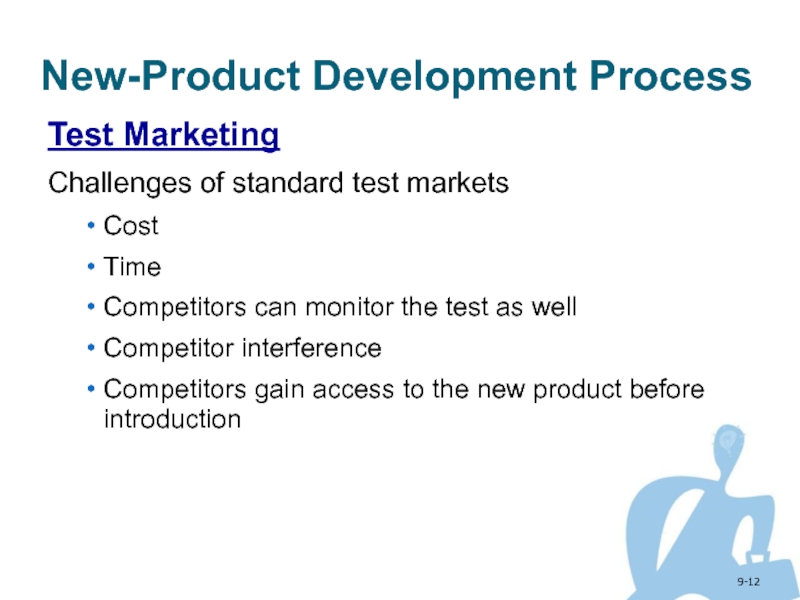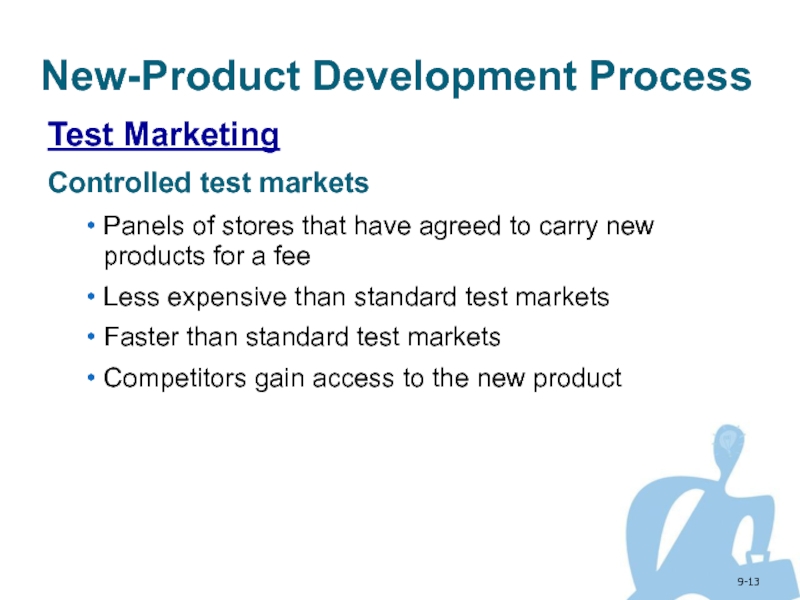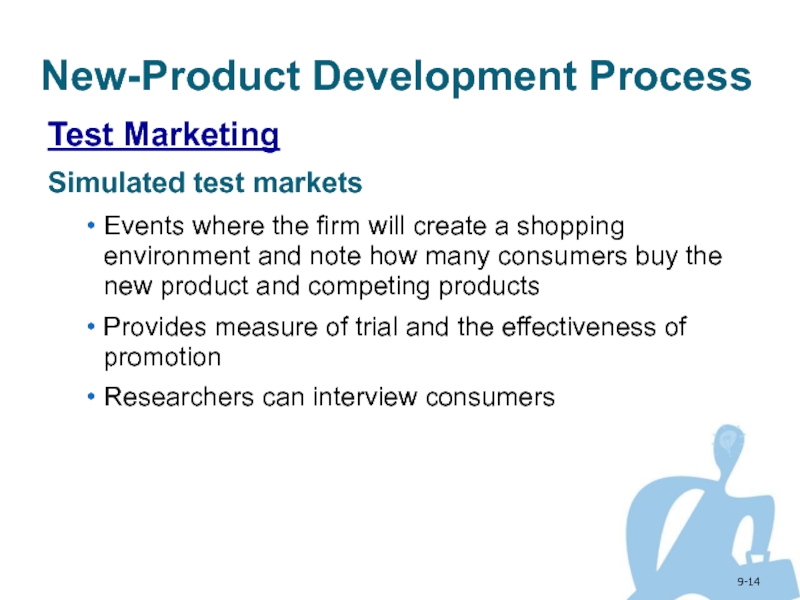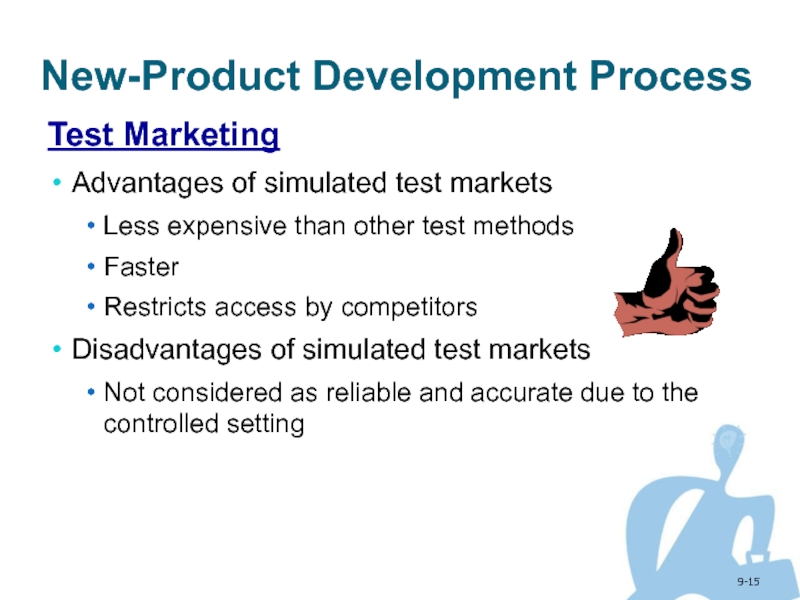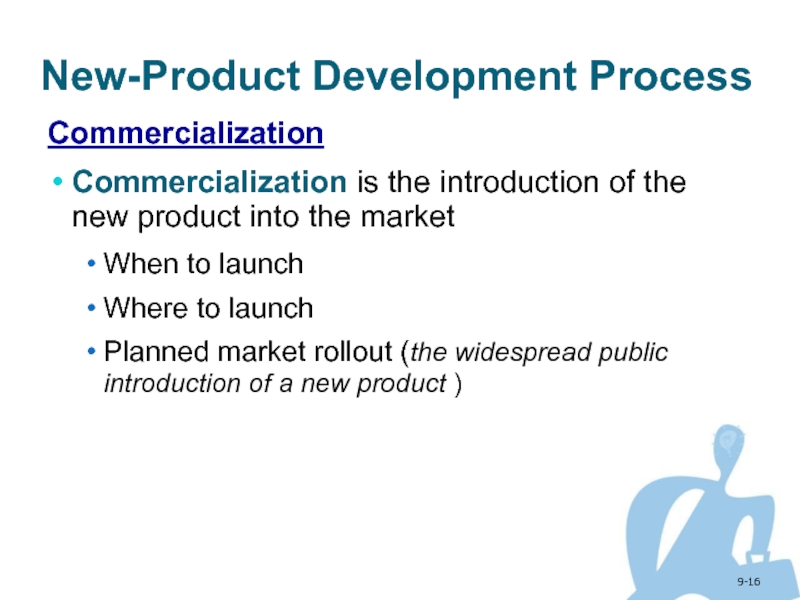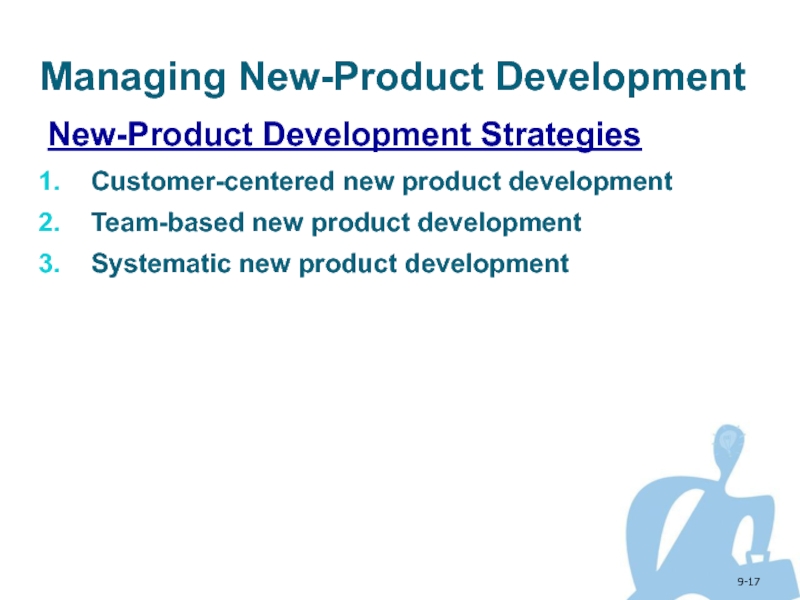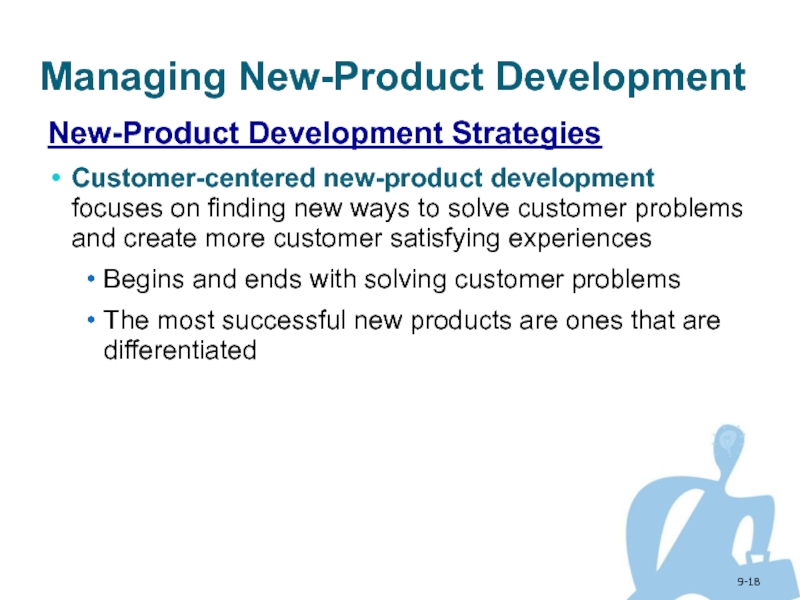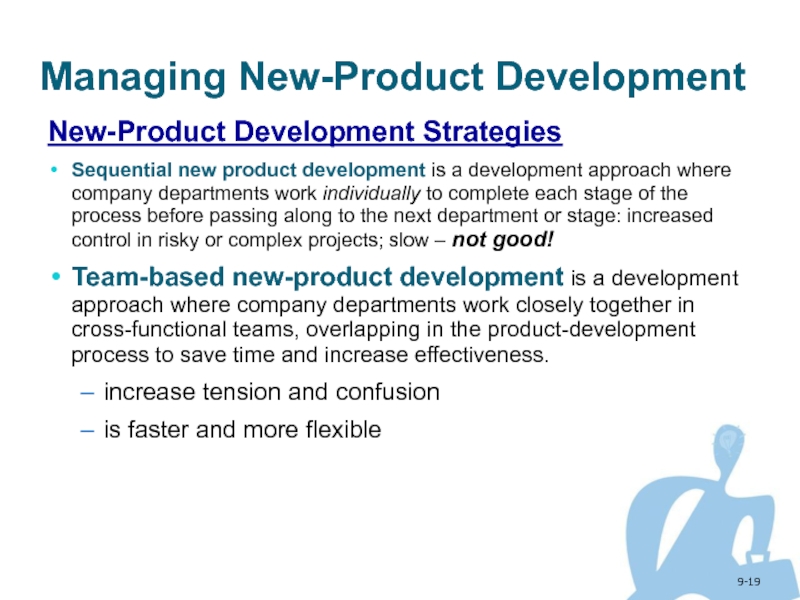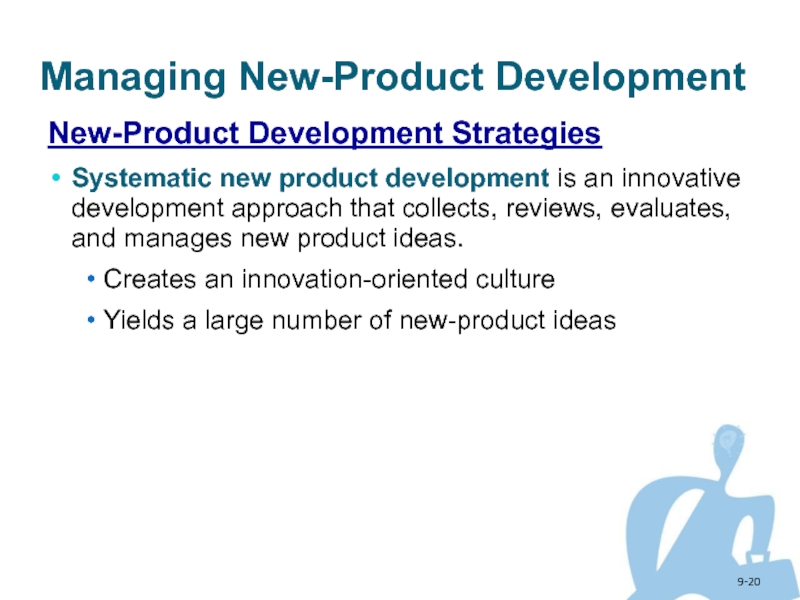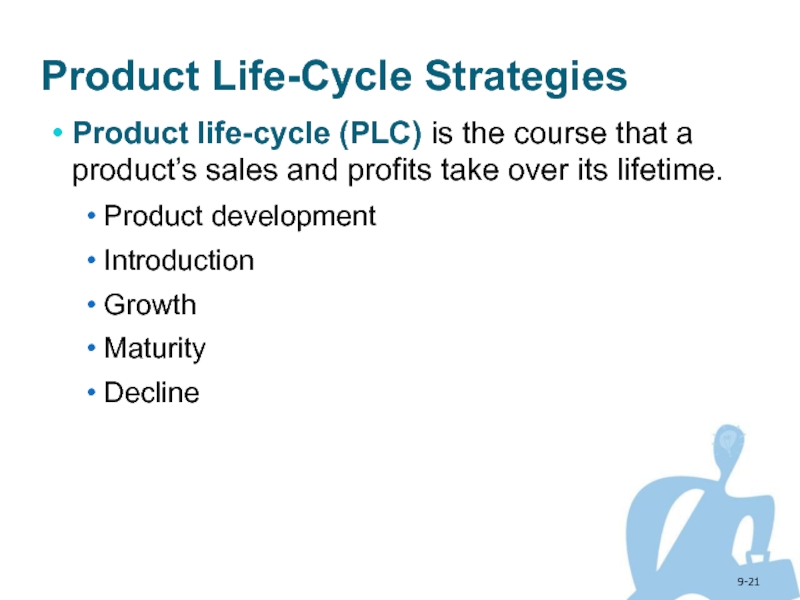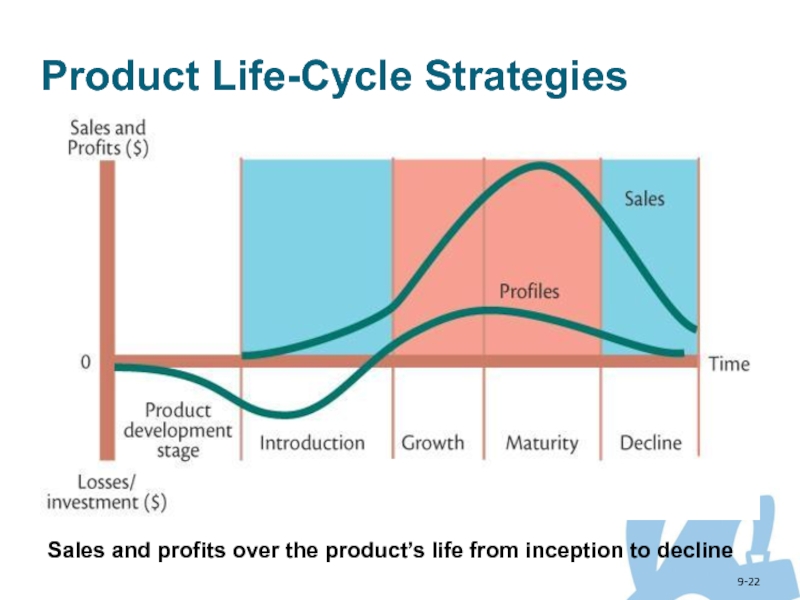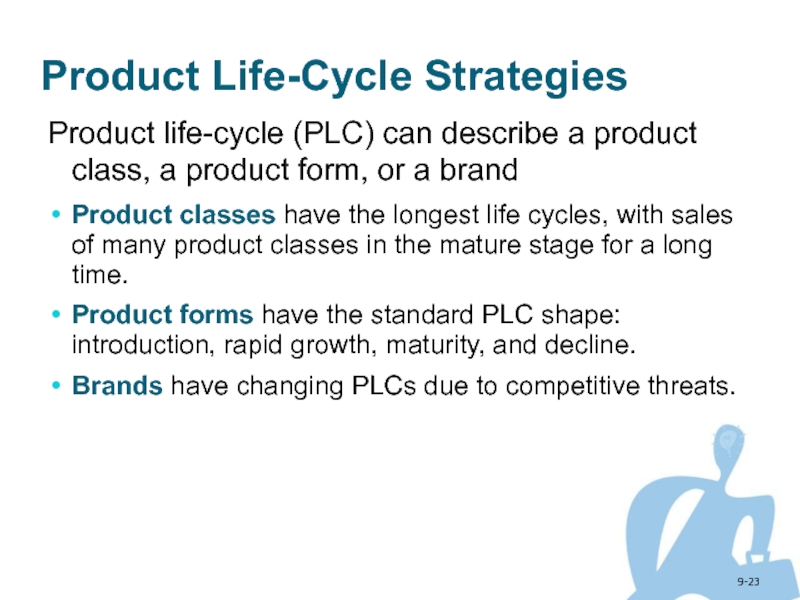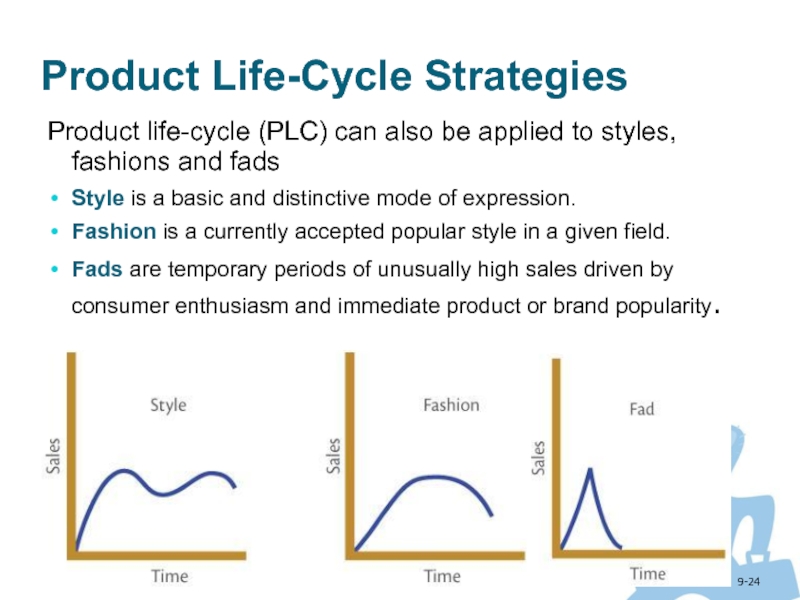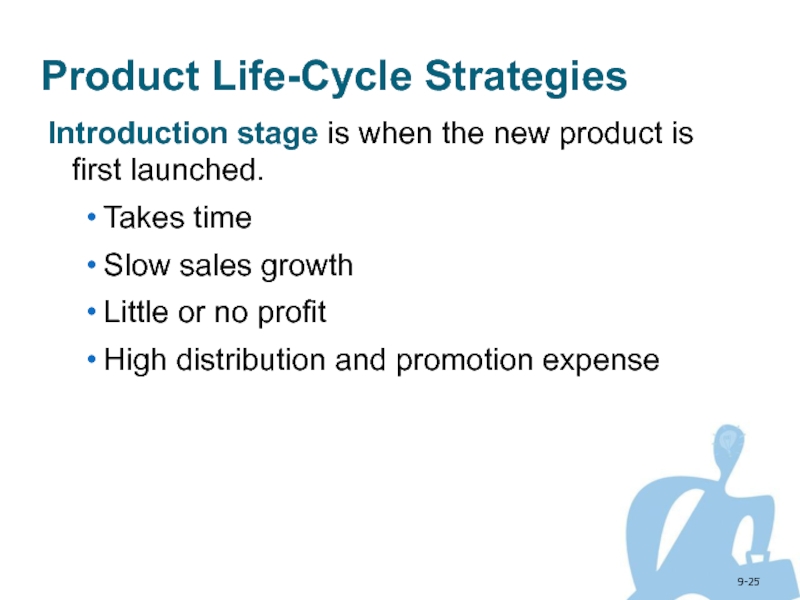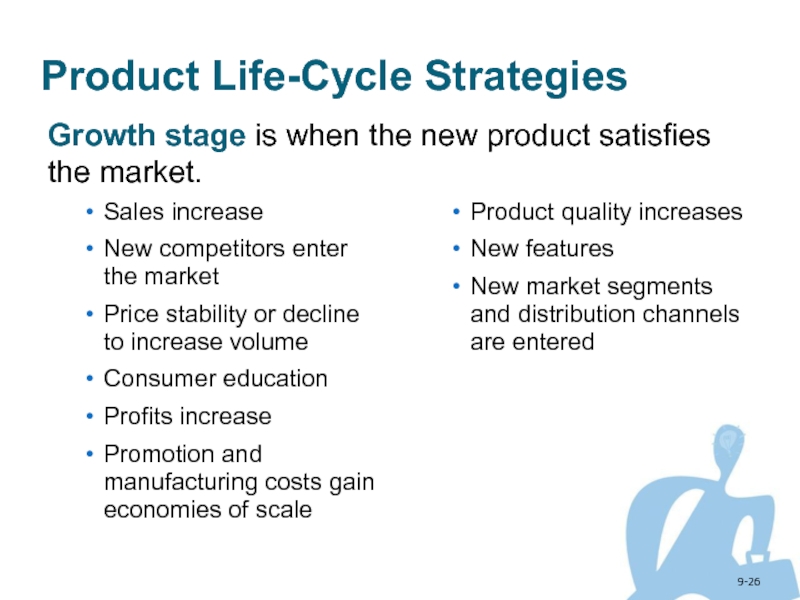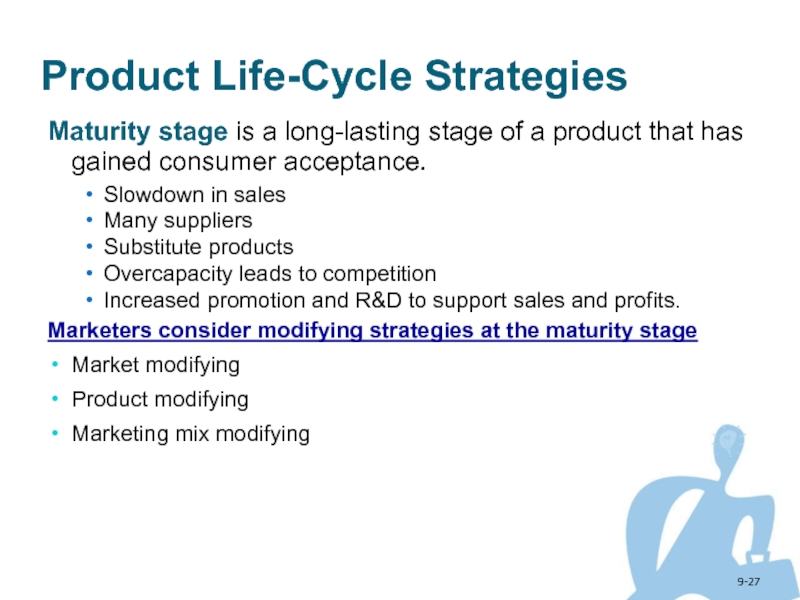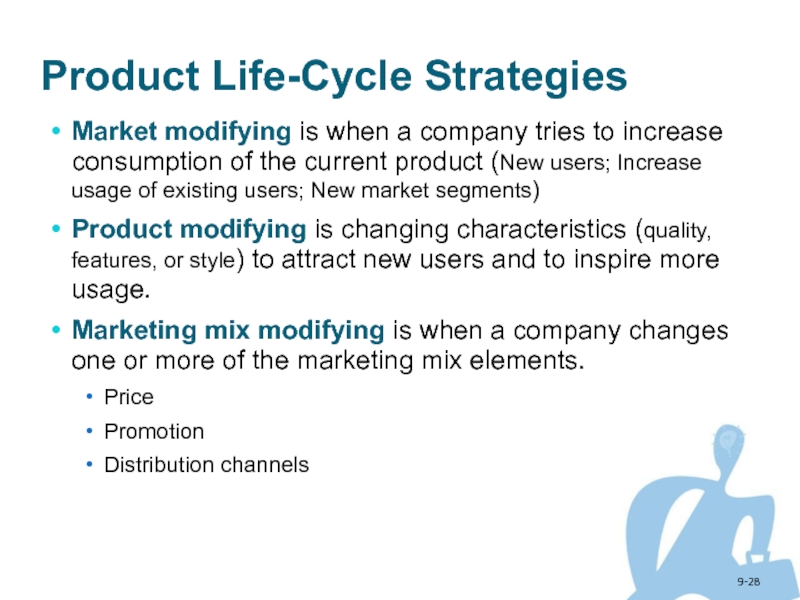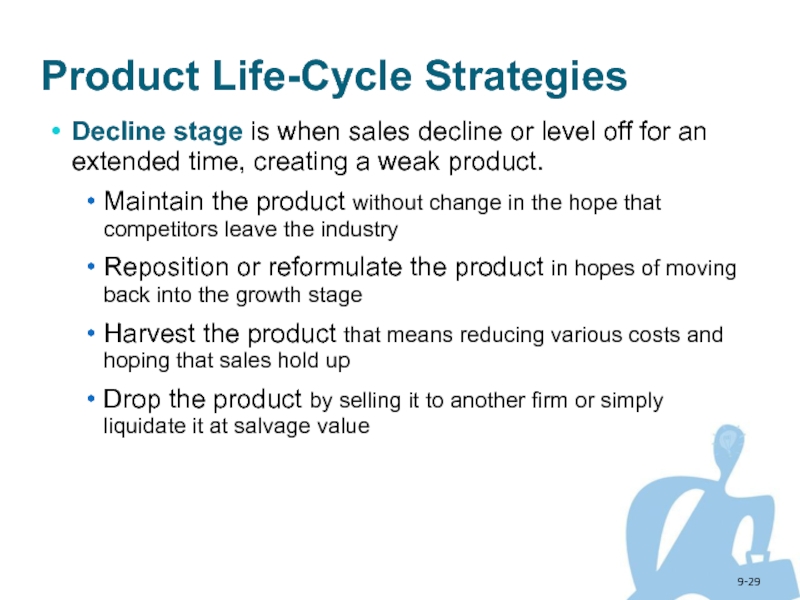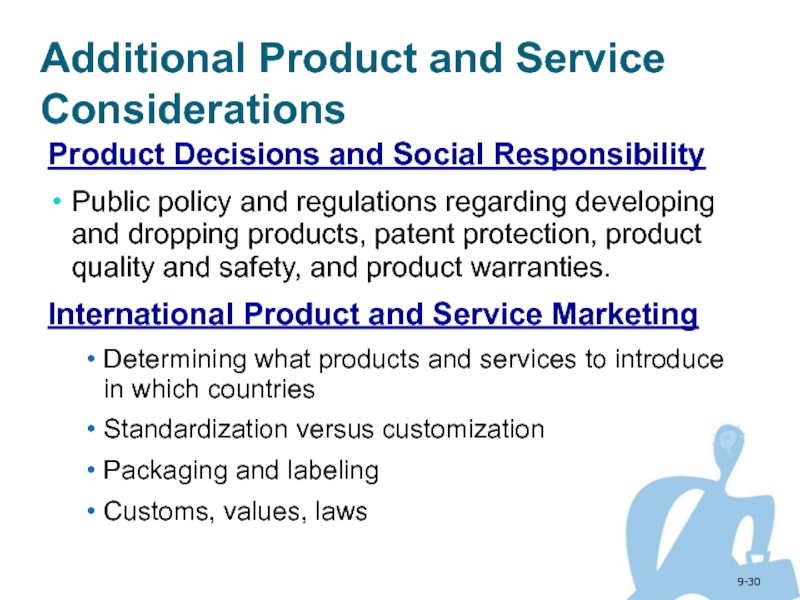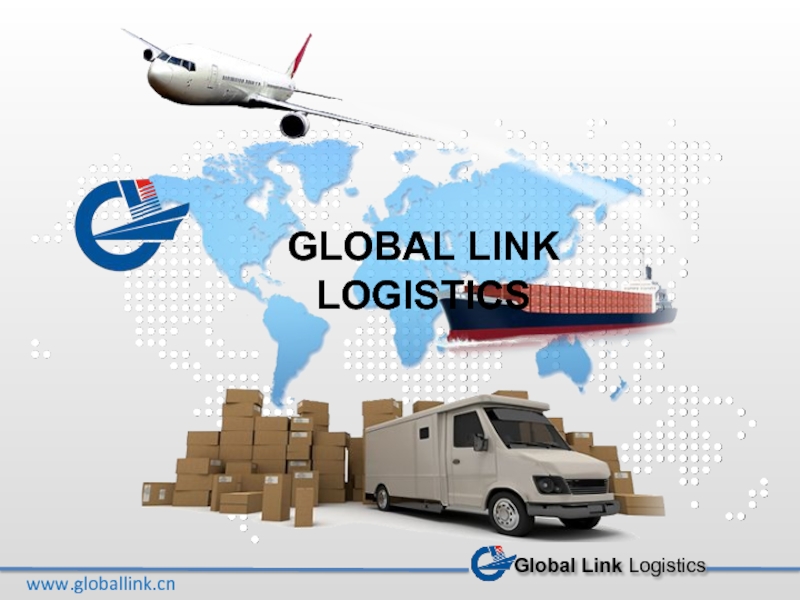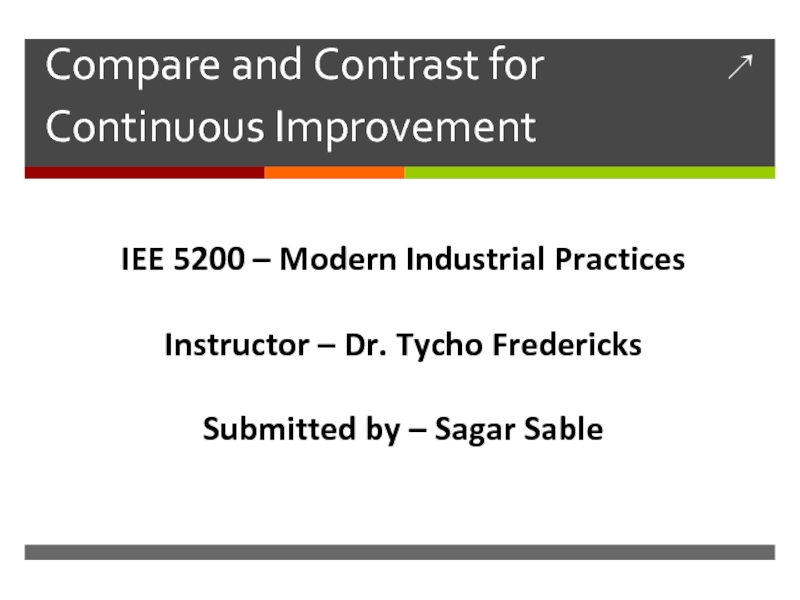- Главная
- Разное
- Дизайн
- Бизнес и предпринимательство
- Аналитика
- Образование
- Развлечения
- Красота и здоровье
- Финансы
- Государство
- Путешествия
- Спорт
- Недвижимость
- Армия
- Графика
- Культурология
- Еда и кулинария
- Лингвистика
- Английский язык
- Астрономия
- Алгебра
- Биология
- География
- Детские презентации
- Информатика
- История
- Литература
- Маркетинг
- Математика
- Медицина
- Менеджмент
- Музыка
- МХК
- Немецкий язык
- ОБЖ
- Обществознание
- Окружающий мир
- Педагогика
- Русский язык
- Технология
- Физика
- Философия
- Химия
- Шаблоны, картинки для презентаций
- Экология
- Экономика
- Юриспруденция
New product development презентация
Содержание
- 1. New product development
- 2. 9- New-Product Development Strategy A firm can
- 3. 9- Reasons for new product failure Overestimation
- 4. 9- New-Product Development Process Idea generation Idea
- 5. 9- New-Product Development Process Idea Generation New
- 6. 9- New-Product Development Process Idea Screening Idea
- 7. 9- New-Product Development Process Marketing Strategy Development
- 8. 9- New-Product Development Process Business Analysis Business
- 9. 9- New-Product Development Process Test Marketing Test
- 10. 9- New-Product Development Process Test Marketing Approaches
- 11. 9- New-Product Development Process Test Marketing
- 12. 9- New-Product Development Process Test Marketing Challenges
- 13. 9- New-Product Development Process Test Marketing Controlled
- 14. 9- New-Product Development Process Test Marketing Simulated
- 15. 9- New-Product Development Process Test Marketing Advantages
- 16. 9- New-Product Development Process Commercialization Commercialization is
- 17. 9- Managing New-Product Development New-Product Development Strategies
- 18. 9- Managing New-Product Development New-Product Development Strategies
- 19. 9- Managing New-Product Development New-Product Development Strategies
- 20. 9- Managing New-Product Development New-Product Development Strategies
- 21. 9- Product Life-Cycle Strategies Product life-cycle (PLC)
- 22. 9- Product Life-Cycle Strategies Sales and
- 23. 9- Product Life-Cycle Strategies Product life-cycle (PLC)
- 24. 9- Product Life-Cycle Strategies Product life-cycle (PLC)
- 25. 9- Product Life-Cycle Strategies Introduction stage is
- 26. 9- Product Life-Cycle Strategies Sales increase New
- 27. 9- Product Life-Cycle Strategies Maturity stage is
- 28. 9- Product Life-Cycle Strategies Market modifying is
- 29. 9- Product Life-Cycle Strategies Decline stage is
- 30. 9- Additional Product and Service Considerations Product
Слайд 29-
New-Product Development Strategy
A firm can obtain new products through:
Acquisition refers to
the buying of a whole company, a patent, or a license to produce someone else’s product.
New product development refers to original products, product improvements, product modifications, and new brands developed from the firm’s own research and development.
New product development refers to original products, product improvements, product modifications, and new brands developed from the firm’s own research and development.
Слайд 39-
Reasons for new product failure
Overestimation of market size
Poor design
Incorrect positioning
Wrong timing
Priced
too high
Ineffective promotion
Management influence
High development costs
Competition
Ineffective promotion
Management influence
High development costs
Competition
New-Product Development Strategy
Слайд 49-
New-Product Development Process
Idea generation
Idea screening
Concept development and testing
Marketing strategy development
Business analysis
Product
development
Test marketing
Commercialization
Test marketing
Commercialization
Слайд 59-
New-Product Development Process
Idea Generation
New idea generation is the systematic search for
new product ideas.
To create a large number of ideas
Sources of new-product ideas
Internal sources refer to the company’s own formal research and development, management and staff, and intrapreneurial programs.
External sources refer to sources outside the company such as customers, competitors, distributors, suppliers, and outside design firms.
To create a large number of ideas
Sources of new-product ideas
Internal sources refer to the company’s own formal research and development, management and staff, and intrapreneurial programs.
External sources refer to sources outside the company such as customers, competitors, distributors, suppliers, and outside design firms.
Слайд 69-
New-Product Development Process
Idea Screening
Idea screening refers to reviewing new-product ideas in
order to drop poor ones as soon as possible.
Concept Development and Testing
Product idea is an idea for a possible product that the company can see itself offering to the market.
Product concept is a detailed version of the idea stated in meaningful consumer terms.
Product image is the way consumers perceive an actual or potential product.
Concept testing refers to testing new-product concepts with groups of target consumers. To find out how attractive each concept is to customers, and choose the best one.
Concept Development and Testing
Product idea is an idea for a possible product that the company can see itself offering to the market.
Product concept is a detailed version of the idea stated in meaningful consumer terms.
Product image is the way consumers perceive an actual or potential product.
Concept testing refers to testing new-product concepts with groups of target consumers. To find out how attractive each concept is to customers, and choose the best one.
Слайд 79-
New-Product Development Process
Marketing Strategy Development
Marketing strategy development refers to the initial
marketing strategy for introducing the product to the market.
Marketing strategy statement
Part 1:
Description of the target market
The planning product positioning; sales, market share, and profit goals
Part 2:
Price distribution and budget
Part 3:
Long-term sales, profit goals, and marketing mix strategy
Marketing strategy statement
Part 1:
Description of the target market
The planning product positioning; sales, market share, and profit goals
Part 2:
Price distribution and budget
Part 3:
Long-term sales, profit goals, and marketing mix strategy
Слайд 89-
New-Product Development Process
Business Analysis
Business analysis involves a review of the sales,
costs, and profit projections to find out whether they satisfy the company’s objectives.
Product Development
Product development involves the creation and testing of one or more physical versions by the R&D or engineering departments. - Requires an increase in investment
Product Development
Product development involves the creation and testing of one or more physical versions by the R&D or engineering departments. - Requires an increase in investment
Слайд 99-
New-Product Development Process
Test Marketing
Test marketing is the stage at which the
product and marketing program are introduced into more realistic marketing settings.
Test marketing provides the marketer with experience in testing the product and entire marketing program before full introduction.
When firms test market: New product with large investment; Uncertainty about product or marketing program
When firms may not test market: Simple line extension; Copy of competitor product; Low costs; Management confidence
Test marketing provides the marketer with experience in testing the product and entire marketing program before full introduction.
When firms test market: New product with large investment; Uncertainty about product or marketing program
When firms may not test market: Simple line extension; Copy of competitor product; Low costs; Management confidence
Слайд 109-
New-Product Development Process
Test Marketing
Approaches to test marketing
Standard test markets
Controlled test markets
Simulated
test markets
Слайд 119-
New-Product Development Process
Test Marketing
Standard test markets
Small representative markets where the firm
conducts a full marketing campaign
Uses store audits, consumer and distributor surveys, and other measures to gauge product performance
Results are used to
Forecast national sales and profits
Discover product problems
Fine-tune the marketing program
Uses store audits, consumer and distributor surveys, and other measures to gauge product performance
Results are used to
Forecast national sales and profits
Discover product problems
Fine-tune the marketing program
Слайд 129-
New-Product Development Process
Test Marketing
Challenges of standard test markets
Cost
Time
Competitors can monitor the
test as well
Competitor interference
Competitors gain access to the new product before introduction
Competitor interference
Competitors gain access to the new product before introduction
Слайд 139-
New-Product Development Process
Test Marketing
Controlled test markets
Panels of stores that have agreed
to carry new products for a fee
Less expensive than standard test markets
Faster than standard test markets
Competitors gain access to the new product
Less expensive than standard test markets
Faster than standard test markets
Competitors gain access to the new product
Слайд 149-
New-Product Development Process
Test Marketing
Simulated test markets
Events where the firm will
create a shopping environment and note how many consumers buy the new product and competing products
Provides measure of trial and the effectiveness of promotion
Researchers can interview consumers
Provides measure of trial and the effectiveness of promotion
Researchers can interview consumers
Слайд 159-
New-Product Development Process
Test Marketing
Advantages of simulated test markets
Less expensive than other
test methods
Faster
Restricts access by competitors
Disadvantages of simulated test markets
Not considered as reliable and accurate due to the controlled setting
Faster
Restricts access by competitors
Disadvantages of simulated test markets
Not considered as reliable and accurate due to the controlled setting
Слайд 169-
New-Product Development Process
Commercialization
Commercialization is the introduction of the new product into
the market
When to launch
Where to launch
Planned market rollout (the widespread public introduction of a new product )
When to launch
Where to launch
Planned market rollout (the widespread public introduction of a new product )
Слайд 179-
Managing New-Product Development
New-Product Development Strategies
Customer-centered new product development
Team-based new product development
Systematic
new product development
Слайд 189-
Managing New-Product Development
New-Product Development Strategies
Customer-centered new-product development focuses on finding new
ways to solve customer problems and create more customer satisfying experiences
Begins and ends with solving customer problems
The most successful new products are ones that are differentiated
Begins and ends with solving customer problems
The most successful new products are ones that are differentiated
Слайд 199-
Managing New-Product Development
New-Product Development Strategies
Sequential new product development is a development
approach where company departments work individually to complete each stage of the process before passing along to the next department or stage: increased control in risky or complex projects; slow – not good!
Team-based new-product development is a development approach where company departments work closely together in cross-functional teams, overlapping in the product-development process to save time and increase effectiveness.
increase tension and confusion
is faster and more flexible
Team-based new-product development is a development approach where company departments work closely together in cross-functional teams, overlapping in the product-development process to save time and increase effectiveness.
increase tension and confusion
is faster and more flexible
Слайд 209-
Managing New-Product Development
New-Product Development Strategies
Systematic new product development is an innovative
development approach that collects, reviews, evaluates, and manages new product ideas.
Creates an innovation-oriented culture
Yields a large number of new-product ideas
Creates an innovation-oriented culture
Yields a large number of new-product ideas
Слайд 219-
Product Life-Cycle Strategies
Product life-cycle (PLC) is the course that a product’s
sales and profits take over its lifetime.
Product development
Introduction
Growth
Maturity
Decline
Product development
Introduction
Growth
Maturity
Decline
Слайд 229-
Product Life-Cycle Strategies
Sales and profits over the product’s life from inception
to decline
Слайд 239-
Product Life-Cycle Strategies
Product life-cycle (PLC) can describe a product class, a
product form, or a brand
Product classes have the longest life cycles, with sales of many product classes in the mature stage for a long time.
Product forms have the standard PLC shape: introduction, rapid growth, maturity, and decline.
Brands have changing PLCs due to competitive threats.
Product classes have the longest life cycles, with sales of many product classes in the mature stage for a long time.
Product forms have the standard PLC shape: introduction, rapid growth, maturity, and decline.
Brands have changing PLCs due to competitive threats.
Слайд 249-
Product Life-Cycle Strategies
Product life-cycle (PLC) can also be applied to styles,
fashions and fads
Style is a basic and distinctive mode of expression.
Fashion is a currently accepted popular style in a given field.
Fads are temporary periods of unusually high sales driven by consumer enthusiasm and immediate product or brand popularity.
Style is a basic and distinctive mode of expression.
Fashion is a currently accepted popular style in a given field.
Fads are temporary periods of unusually high sales driven by consumer enthusiasm and immediate product or brand popularity.
Слайд 259-
Product Life-Cycle Strategies
Introduction stage is when the new product is first
launched.
Takes time
Slow sales growth
Little or no profit
High distribution and promotion expense
Takes time
Slow sales growth
Little or no profit
High distribution and promotion expense
Слайд 269-
Product Life-Cycle Strategies
Sales increase
New competitors enter the market
Price stability or decline
to increase volume
Consumer education
Profits increase
Promotion and manufacturing costs gain economies of scale
Consumer education
Profits increase
Promotion and manufacturing costs gain economies of scale
Product quality increases
New features
New market segments and distribution channels are entered
Growth stage is when the new product satisfies the market.
Слайд 279-
Product Life-Cycle Strategies
Maturity stage is a long-lasting stage of a product
that has gained consumer acceptance.
Slowdown in sales
Many suppliers
Substitute products
Overcapacity leads to competition
Increased promotion and R&D to support sales and profits.
Marketers consider modifying strategies at the maturity stage
Market modifying
Product modifying
Marketing mix modifying
Slowdown in sales
Many suppliers
Substitute products
Overcapacity leads to competition
Increased promotion and R&D to support sales and profits.
Marketers consider modifying strategies at the maturity stage
Market modifying
Product modifying
Marketing mix modifying
Слайд 289-
Product Life-Cycle Strategies
Market modifying is when a company tries to increase
consumption of the current product (New users; Increase usage of existing users; New market segments)
Product modifying is changing characteristics (quality, features, or style) to attract new users and to inspire more usage.
Marketing mix modifying is when a company changes one or more of the marketing mix elements.
Price
Promotion
Distribution channels
Product modifying is changing characteristics (quality, features, or style) to attract new users and to inspire more usage.
Marketing mix modifying is when a company changes one or more of the marketing mix elements.
Price
Promotion
Distribution channels
Слайд 299-
Product Life-Cycle Strategies
Decline stage is when sales decline or level off
for an extended time, creating a weak product.
Maintain the product without change in the hope that competitors leave the industry
Reposition or reformulate the product in hopes of moving back into the growth stage
Harvest the product that means reducing various costs and hoping that sales hold up
Drop the product by selling it to another firm or simply liquidate it at salvage value
Maintain the product without change in the hope that competitors leave the industry
Reposition or reformulate the product in hopes of moving back into the growth stage
Harvest the product that means reducing various costs and hoping that sales hold up
Drop the product by selling it to another firm or simply liquidate it at salvage value
Слайд 309-
Additional Product and Service Considerations
Product Decisions and Social Responsibility
Public policy and
regulations regarding developing and dropping products, patent protection, product quality and safety, and product warranties.
International Product and Service Marketing
Determining what products and services to introduce in which countries
Standardization versus customization
Packaging and labeling
Customs, values, laws
International Product and Service Marketing
Determining what products and services to introduce in which countries
Standardization versus customization
Packaging and labeling
Customs, values, laws
